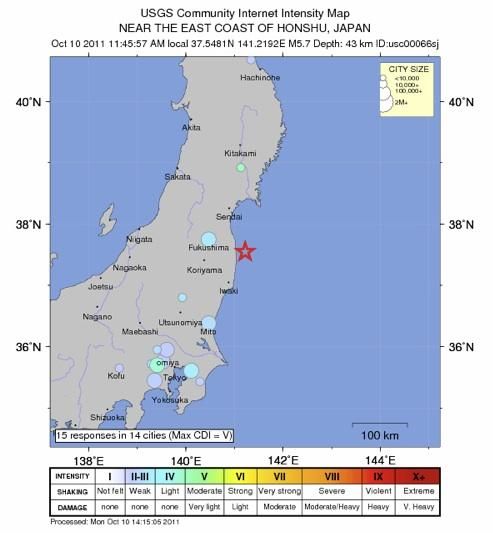
Big Aftershocks Rattle Quake-Weary Japan, New Zealand

Two regions that were hit hard by earthquakes this year were both rocked by aftershocks within hours of each other last night and early this morning.
Christchurch, New Zealand, was shaken by a magnitude 4.7 earthquake last night (Oct. 9), according to the U.S. Geological Survey (USGS). The quake was an aftershock of the magnitude 6.3 earthquake struckthat city on Feb. 22, killing 181 people.
Just hours after the Christchurch aftershock, a magnitude 5.7 quake rattled Honshu, Japan, this morning (Oct. 10). On March 11, a magnitude 9.0 quake struck off the island's coast. It was the fifth-most powerful quake ever recorded .The quake set off atsunami that devastated the region, killing an estimated 30,000 people and damaging the nearby Fukushima-Daiichi nuclear power plant.
There were no reports of significant damage or injuries from either of the most recent temblors in New Zealand and Japan.
The recent quakes are considered aftershocks, which have become a frighteningly common occurrence in both regions and have hampered rebuilding efforts.
The timing was merely a coincidence, since each region has felt so many aftershocks.
"Once in a while they're going to be at the same time of day," said Don Blakeman, a geophysicist with the USGS. "Both are continuing and that's no surprise."
Sign up for the Live Science daily newsletter now
Get the world’s most fascinating discoveries delivered straight to your inbox.
Aftershocks are common even years after a large earthquake. The magnitude 6.3 earthquake in Christchurch was itself an aftershock of a less-damaging magnitude 7.1 quake that struck in a less populated area in September 2010. Japan has been rocked by hundreds of aftershocks since the deadly Tohoku earthquake. The aftershocks have been so plentiful that the world's premier earthquake-measurement service has since modified its alert system to filter out the smaller aftershocks.
The rule of thumb for aftershock strength is that the biggest aftershock will be about one magnitude smaller than the main shock. The bigger aftershocks tend to come sooner after the initial quake, with subsequent aftershocks tapering off in strength; but some aftershocks can buck this trend.
Both Japan and New Zealand lie along the volatile Pacific Ring of Fire a narrow zone around the Pacific Ocean where a large chunk of the planet's earthquakes and volcanic eruptions occur. About 90 percent of all the world's earthquakes, and 80 percent of the largest ones, strike along the Ring of Fire.
"Of course, we don't know when the next [aftershocks] will be because we can't predict them," Blakeman told OurAmazingPlanet.
Today's large aftershock in Japan was felt as far away as Tokyo, but no significant damage was reported. The Fukushima-Daiichi nuclear plant remained stable.
Christchurch's quake was "big and noisy" according to the New Zealand Herald, but there were no significant reports of damage or injuries.
- 7 Ways the Earth Changes in the Blink of an Eye
- Image Gallery: This Millennium's Destructive Earthquakes
- The 10 Biggest Earthquakes in History
Follow OurAmazingPlanet for the latest in Earth science and exploration news on Twitter @OAPlanet and on Facebook.












